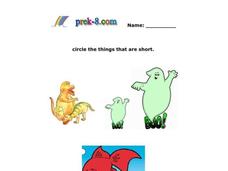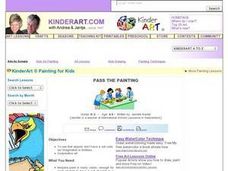Curated OER
Size Worksheet: Long And Short
In this size worksheet, students will analyze pictures using long and short. Students will match 4 short objects to their corresponding long objects in the opposite column.
Curated OER
Short and Long
In this size comparison worksheet, students study the pictures illustrated on the page. Students identify the objects that are shorter in comparison and circle them.
Curated OER
Classification and Identification
Students, after exploring and analyzing diagrammatic and taxonomic keys and their association to marine sciences, identify and classify objects and organisms based on visual attributes/characteristics. They research and create their own...
Curated OER
Comic Theater
Students explore stock characters and pantomime. In this comic theater lesson, students examine an ancient Greek statuette depicting a comic actor and an ancient Roman lamp decorated with a comic mask. Students pantomime short scenes and...
Curated OER
Number Recognition Games
Students explore number sense by participating in a math recognition activity. In this number identification instructional activity, students practice pronouncing names of numbers and matching the number with an amount of objects....
Curated OER
Momentum of Line in Art
For this momentum worksheet, students read about how artists use the term momentum to describe how a viewer's eyes move a long a line. Then students complete 4 short answer questions.
Curated OER
Archeologists For a Day
Students listen to a reading about fossils and go on a hunt for items with fossil characteristics. In this cross curricular fossil lesson, students will examine their fossil finds and create a graphic organizer. Students listen to...
Curated OER
Dance Challenge: Calculate and Compare Speed by Measuring a Series of Dance Movements
Really neat! Kids choreograph a dance phrase and then measure the distance and speed of the phrase using a timer and a meter stick. They collect the data on a table which they use to determine an average. A series of observation and...
Curated OER
Play a Painting
Students examine music and art together and see the distinctive elements of each form. It can also demonstrate how their characteristics are interrelated. They create musical interpretations of two works of art.
Curated OER
Line: a Geometric Exercise
Students study the different types of lines and create a drawing demonstrating what they learned.
Curated OER
Pass the Painting
After reading a story or informational text describing an animal, your class gets creative and collaborative with paint. In groups, they brainstorm all the parts of an animal, they then take turns painting those parts. One child starts...
Curated OER
Drawing - Swan Lesson and the Blue Heron Lesson
Students draw a swan and heron from step-by-step instructions. They discuss characteristics of the swan and its environment. Students study and write a paragraph, story, or report illustrating their picture.
Curated OER
The History of Photography
By discussing the history of photography, students can learn about this art and its importance in recording major events.
Curated OER
Drawing Birds
First graders discuss what they know about birds and share picture books. They read text on the page and discuss the question and draw the flying bird on their paper by having them look at the color drawing of the bird.
Curated OER
Thirty-Second Look
Students articulate why more than 30 seconds is required to examine a work of art, in order to gain an understanding of it. They give reasons why discussing a work of art increases their understanding of it.
















